I'm going to backtrack a little. My last post left off with us descending into the Sacred Valley but I forgot to share the second half of our trip to the llama farm. It was a demonstration of weavers that had come from all the surrounding areas to show turistas like us how they weave and their traditional dress.


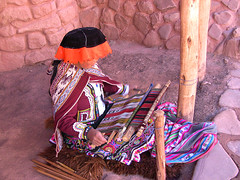
Weavers
Click image to view full size
The weaver in the middle photo is a young 14 year old boy named "Jonathan". Our guide Fredy was a little surprised at this but went on to say that in some of the villages male weavers were more common and a man that knew how to weave was desirable as a mate. Traditionally women did the weaving though and textiles held as much value as gold in prehispanic Inca culture.
After visiting with the weavers with translations from our guide, we were herded into a gift shop full of weavings. This shop was different in that the sales went to benefit the local weavers we were told. But it was a gift shop nevertheless.
We continued on our way to the Sacred Valley. At one point our tour guide, Fredy, had the bus stop by the side of the road to watch and visit with a local farmer, named Vincente, who was threshing wheat using donkeys. This was a completely impromptu stop and a lot of fun.
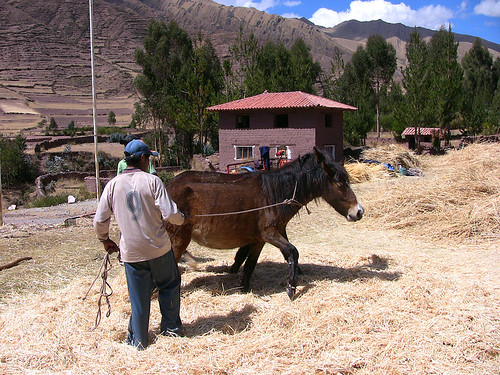
The Sacred Valley
Click image to view full size
Soon we were back on the bus descended into the Sacred Valley of the Urubamba river and headed to the town of Pisac or Pisaq.
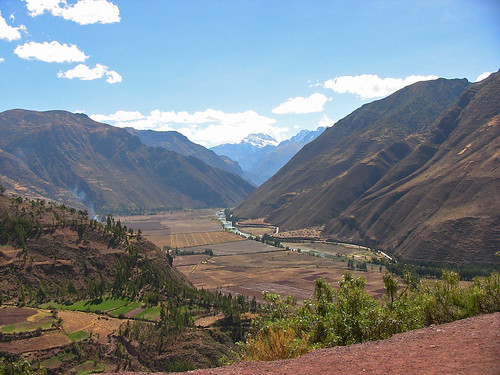
The Sacred Valley
Click image to view full size
INCA PISAC
Pisac is about 19 miles northwest of Cuzco and is a major archaeological park in the region. In truth there are really two Pisacs. The ancient Inca town (ruins in the archaeological park) and the modern colonial town, which is the living town today.
The ancient town of Pisac dates to pre-Inca times. The site today is dominated by curving terraces built into the hill sides allowing the Incas to take advantage of every bit of sun light. Another advantage to building on the hillsides was the views that allowed people to see any approaching attacks. There seemed to be a concern about attacks coming up from the Amazon river area, which was one of the four large sections of the Inca empire called Antisuyo, from which the name Andes was derived from.

Terraces of Pisac
Click image to view full size
If you view the image full size by clicking on it you can really see how steep the terraces are. Keep in mind this only about a fourth of the total site. There are terraces covering all the nearby hillsides wrapping around behind the hills on the right side of the photo. Also in this photo you can see the colonial town of Pisac, or part of it.
To make better use of our time there our bus drove up the back side of the site to the Qanchisraqay or Kanturaqay sector of the site. This area is outside of the fortified city. From here we could walk to an area which housed the soldiers and encounter a trapezoid door/gate of the city's wall.
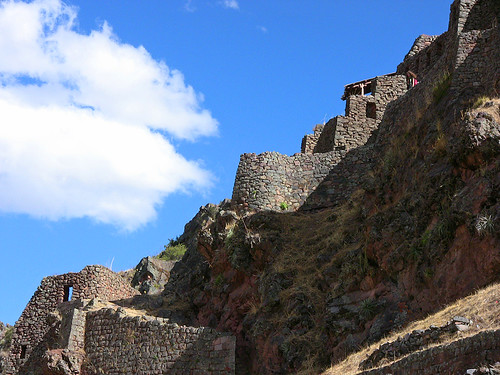
Soldier Sector
Click image to view full size
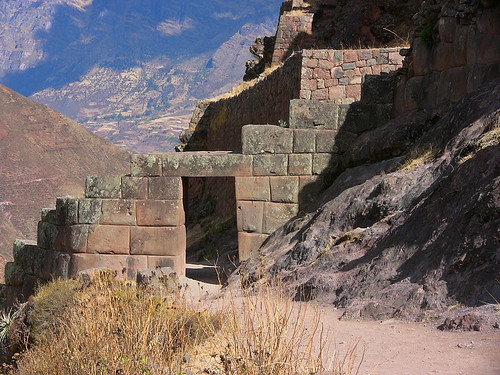
The Mortar-less Gate
Click image to view full size
This gate is made of mortar-less stone, a sign of it's significance. Mortar-less walls required greater craftsmanship and precision in their construction and are found mostly in religious buildings, such as temples, and building for the Inca king, like his palaces.
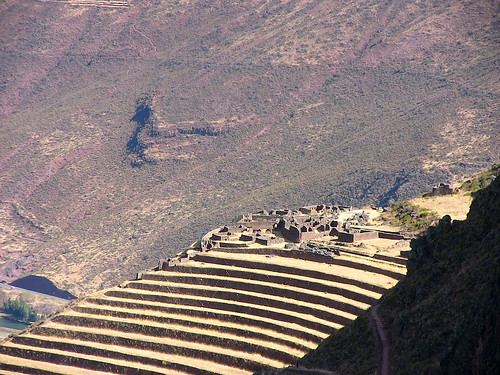
More terraces at Pisac
Click image to view full size
The photo above shows the religious sector of the town situated above more terraces. This area had a Intiwatana, or Hitching Post of the Sun. Intiwatanas are very sacred and this area was most likely the most important part of the entire site where ceremonies were conducted.
If you click on the photo to view it full size you can barely make out V shaped dots in the walls. These are the so called "Flying Steps", stones that protruded from the walls like stairs for easy access up and down the terraces.
Inca Pisac video. Click to Play
MY FIRST MUSICAL INSTRUMENT PURCHASE
Almost every time the bus stopped at a location there were people, adults and kids alike, hocking their wares. Some of it was nice textiles, some was cheap junk. At Inca Pisac we were greeted by several women with stuff, but there was a guy there selling Quenas, the rim blown flute of the Andes. I had planned to buy one (or two) during the trip and even though my Spanish was bad, his English was worse, but we managed to communicate somehow, and I tried them out and found one I liked. So I bought it right on the spot. It was great to be playing this flute, which has been a part of the Andean culture for over a thousand years at such an ancient site!

Holding my new Quena with the guy I bought it from
Click image to view full size
Since this purchase I've performed, or I should say "mangled", Cactus Dance a couple times on this flute during some of my performances, including at the most recent Yosemite Flute Festival.
Our time at Inca Pisac was very short, only about an hour. I did not realize how large and impressive the ruins would be and, as I love archaeological sites, wanted to spend a whole day exploring each section in detail. I was bummed when it came time to leave. However our next stop, the famous market down the hill in colonial Pisac turned out to be a lot of fun.
But that needs to wait until next time.
If you've missed the first three parts here are their links
Part 1: "Journey to Peru"
Part 2: "Lost in Translation"
Part 3: "Flight of the (Silver) Condor"
I am absolutely loving these articles! They are well done with great pictures! To only have had an hour...just not enough time, for sure. This is a beautiful location on a beautiful day - that would have been great to have had more time.
ReplyDeleteHi Scott,
ReplyDeleteLoved the blog. Have always been interested in going to Peru, but have not been able to. Thoroughly enjoyed the story. Thank you.
Lee.
thanks for the at-home tour. your pictures are tremendous and will temporarily appease those of us who must see Machu Piccu before we die. - marty-in-oregon
ReplyDeleteThank you for letting me get a glimse of Peru
ReplyDeleteI am going next month and your documentry has
helped me get a head start.
You are very talented!!!!
Thank you for the awesome view of Peru! Wer'e
ReplyDeletegoing down next week & hope to see a lot of the same places. I'm more excited than ever now!
Scott,
ReplyDeleteThank your for sharing your trip! The pictures are beautiful and your comments bring to life a place that I probably will never have the opportunity to experience...Tish from Phx.
Just got back from a very similar trip to yours and visited almost all of the same sites. Your writing style is great and has more detail than my memory. I want to chronologue our trip, but time and effort are making things fade... Anyway, thanks for your efforts! This is great.
ReplyDelete